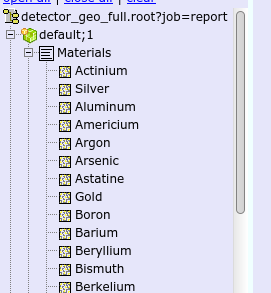Table of Contents
Setup
Note all these commands assume you are in an eic-shell singularity session.
Clone part2 repo
Compile the detector library
How to build a detector from scratch
Building a new (generic) detector using dd4hep is rather straight forward if we make the following assumptions.
- We will use the built-in sensitive detectors
- We will use the dd4pod data model (i.e. use
npsim)
Compiling a new detector
For this tutorial we will build a more detailed GEM detector.
We will discuss the detector built in the source file
src/TrapEndcapTracker_geo.cpp.
In the CMakeLists.txt it adds all cpp files, otherwise we would do
Building the geometry (cpp + xml)
The work of constructing the detector is done in a static function (here called
build_detector) that is registered using the DD4hep plugin macro
DECLARE_DETELEMENT.
The argument signature of the build_detector is:
Detector& dtor: This handle provides the main hook to the detector tree (dd4hep::Detector).xml_h e: Handle to the XML<detector>tag associated with the detector in the "compact" detector description file (more on this later). This provides the mechanism for feeding in the run-time construction parameters.SensitiveDetector sens: The sensitive detector to be assigned to the sensitive volumes/elements of the detector.
The DD4hep plugin macro DECLARE_DETELEMENT(MyGEMTrackerEndcap, build_detector)
stamps out the necessary boiler plate code to register a new detector called
MyGEMTrackerEndcap which is build by calling build_detector.
Compact detector description entry element
The <detector> tag defines a new instance of a detector and requires the
attributes "id", "name", and "type". For example from part 1:
This defines an instance of the detector named "GEMTracker" of type
"my_GEMTracker" (i.e. the type-name given in the first argument of the DD4hep
DECLARE_DETELEMENT macro) and with id=2. Each <detector> must have a unique id.
The additional attributes (vis, readout, zoffset) are optional.
The detector tag is provided as the second argument in the build_detector
function. It can be parsed how ever you want in order to extract detector
information. The allowed attributes are listed in
UnicodeValues.h
where it is clear how to add new attributes.
Geometry Construction
If you are familiar with Geant4 or TGeo geometry construction then this will be easy. DD4hep has TGeo under hood but there are a few naming tweaks. The following table will help orient the user.
| DD4hep | Geant4 | *TGeo |
|---|---|---|
| Solid | G4VSolid | TGeoShape |
| Volume | G4LogicalVolume | TGeoVolume |
| PlacedVolume | G4PVPlacement | TGeoNode |
| Element | G4Element | TGeoElement |
| Material | G4Material | TGeoMaterial/TGeoMedium |
XML Parsing Tip : Provide good default values
If you have a detector parameter which we later will tweak (while optimizing the design) try to get the value from the xml element but provide a good default value. For example:
This provides a default radius of 5 cm when x_det does not have a "radius"
attribute defined. We will return to this later.
Critical parts of build_detector
We will now look at the function in src/GEMTrackerDisc_geo.cpp.
Note that this is not a good example to copy, rather it is a simple example to walk through.
Here is the XML again:
What problems do you see with this construction?
- rigid
- hard coded
- no defaults
- single material
- lots more...
What materials exist?
To browse the list of materials and elements (other than looking in the compact files), go to
geo viewer
and scroll through the materials.

Here we are grabbing the materials that are assumed to be already defined. Also
we are getting the detector id and name defined in the detector tag.
Next we define an Assembly
volume.
Here we also stumble upon the important class
dd4hep::DetElement.
It is a means of providing the detector hierarchy/tree, but doesn't necessarily
have to map exactly to detector geometry. However, it typically will typically
parallel the geometry (and probably should).
A more detailed GEM Tracker
Uncomment the include line in gem_tracker.xml
And have a look at the detector part of compact/gem_tracker_endcap.xml.
Here you see a different strategy: build a module, then build layers constructed from the module.
The corresponding detector constructor function is in src/TrapEndcapTracker_geo.cpp
![]()
Hands on challenges
Update gem tracker
Swap out the gem tracker from part 1 with the detailed construction.
Add top and bottom support for the GEM foil frame.
There is a side currently there
Make the modules overlap
Currently the modules do not overlap much. Can you come up with a way to modify to get a nice overlap?
What bug exists with the negative endcap?
If you uncomment the negative endcap, can you find out what is wrong with the construction?
Edit this page on eicweb